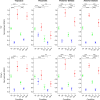Effects of Simulated Microgravity and Hypergravity Conditions on Arm Movements in Normogravity
- PMID: 34970122
- PMCID: PMC8712641
- DOI: 10.3389/fncir.2021.750176
Effects of Simulated Microgravity and Hypergravity Conditions on Arm Movements in Normogravity
Abstract
The human sensorimotor control has evolved in the Earth's environment where all movement is influenced by the gravitational force. Changes in this environmental force can severely impact the performance of arm movements which can be detrimental in completing certain tasks such as piloting or controlling complex vehicles. For this reason, subjects that are required to perform such tasks undergo extensive training procedures in order to minimize the chances of failure. We investigated whether local gravity simulation of altered gravitational conditions on the arm would lead to changes in kinematic parameters comparable to the full-body experience of microgravity and hypergravity onboard a parabolic flight. To see if this would be a feasible approach for on-ground training of arm reaching movements in altered gravity conditions we developed a robotic device that was able to apply forces at the wrist in order to simulate micro- or hypergravity conditions for the arm while subjects performed pointing movements on a touch screen. We analyzed and compared the results of several kinematic parameters along with muscle activity using this system with data of the same subjects being fully exposed to microgravity and hypergravity conditions on a parabolic flight. Both in our simulation and in-flight, we observed a significant increase in movement durations in microgravity conditions and increased velocities in hypergravity for upward movements. Additionally, we noted a reduced accuracy of pointing both in-flight and in our simulation. These promising results suggest, that locally simulated altered gravity can elicit similar changes in some movement characteristics for arm reaching movements. This could potentially be exploited as a means of developing devices such as exoskeletons to aid in training individuals prior to undertaking tasks in changed gravitational conditions.
Keywords: arm kinematics; exoskeletons; hypergravity; microgravity; parabolic flight; robot assisted training.
Copyright © 2021 Jamšek, Kunavar, Blohm, Nozaki, Papaxanthis, White and Babič.
Conflict of interest statement
The authors declare that the research was conducted in the absence of any commercial or financial relationships that could be construed as a potential conflict of interest.
Figures









Similar articles
-
Effects of Local Gravity Compensation on Motor Control During Altered Environmental Gravity.Front Neural Circuits. 2021 Oct 21;15:750267. doi: 10.3389/fncir.2021.750267. eCollection 2021. Front Neural Circuits. 2021. PMID: 34744639 Free PMC article.
-
Shift in arm-pointing movements during gravity changes produced by aircraft parabolic flight.Biol Sci Space. 1999 Jun;13(2):77-81. doi: 10.2187/bss.13.77. Biol Sci Space. 1999. PMID: 11542494
-
Effect of gravity-like torque on goal-directed arm movements in microgravity.J Neurophysiol. 2012 May;107(9):2541-8. doi: 10.1152/jn.00364.2011. Epub 2012 Feb 1. J Neurophysiol. 2012. PMID: 22298835
-
The brain in micro- and hypergravity: the effects of changing gravity on the brain electrocortical activity.Eur J Sport Sci. 2014;14(8):813-22. doi: 10.1080/17461391.2014.908959. Epub 2014 Apr 15. Eur J Sport Sci. 2014. PMID: 24734884 Review.
-
Responses across the gravity continuum: hypergravity to microgravity.Adv Space Biol Med. 2005;10:225-45. doi: 10.1016/s1569-2574(05)10009-4. Adv Space Biol Med. 2005. PMID: 16101110 Review.
Cited by
-
Surface Electromyography Provides Neuromuscular Insights for Skill Acquisition in Microgravity.Proc Int Astronaut Congr. 2022 Sep;73:68484. Proc Int Astronaut Congr. 2022. PMID: 37234941 Free PMC article.
-
Effects of altered gravity on growth and morphology in Wolffia globosa implications for bioregenerative life support systems and space-based agriculture.Sci Rep. 2024 Jan 3;14(1):410. doi: 10.1038/s41598-023-49680-3. Sci Rep. 2024. PMID: 38172193 Free PMC article.
-
Paving the way to better understand the effects of prolonged spaceflight on operational performance and its neural bases.NPJ Microgravity. 2023 Jul 31;9(1):59. doi: 10.1038/s41526-023-00295-y. NPJ Microgravity. 2023. PMID: 37524737 Free PMC article. Review.
References
-
- Artiles A. D., Schor D., Clément G. (2018). “Effects of inverted vision on hand-pointing performance in altered gravity during parabolic flight,” in IEEE Aerospace Conference Proceedings, (Big Sky, MT, USA: IEEE Computer Society; ), 1–9. 10.1109/AERO.2018.8396370 - DOI
-
- Berger M., Mescheriakov S., Molokanova E., Lechner-Steinleitner S., Seguer N., Kozlovskaya I. (1997). Pointing arm movements in short- and long-term spaceflights. Aviat. Space Environ. Med. 68, 781–787. - PubMed
-
- Bock O., Arnold K. E., Cheung B. S. K. (1996). Performance of a simple aiming task in hypergravity: II. Detailed response characteristics. Aviat. Space Environ. Med. 67, 133–138. - PubMed
-
- Bock O., Howard I. P., Money K. E., Arnold K. E. (1992). Accuracy of aimed arm movements in changed gravity. Aviat. Space Environ. Med. 63, 994–998. - PubMed
-
- Bolender H., Stevenin H., Bessone L., Torres A. (2006). Preparing for space. Eur. Space Agency Bull. 128, 32–40. Available online at: https://www.esa.int/esapub/bulletin/bulletin128/bulletin128.pdf.
Publication types
MeSH terms
LinkOut - more resources
Full Text Sources

